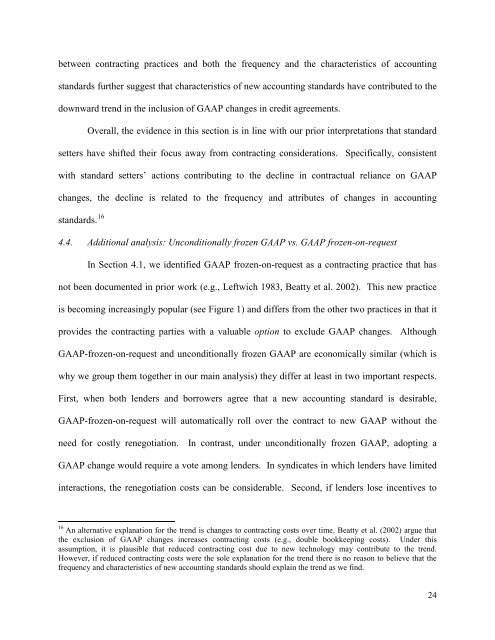Debt Contracts and the Need for Mandatory Accounting Changes ...
Debt Contracts and the Need for Mandatory Accounting Changes ...
Debt Contracts and the Need for Mandatory Accounting Changes ...
Create successful ePaper yourself
Turn your PDF publications into a flip-book with our unique Google optimized e-Paper software.
etween contracting practices <strong>and</strong> both <strong>the</strong> frequency <strong>and</strong> <strong>the</strong> characteristics of accounting<br />
st<strong>and</strong>ards fur<strong>the</strong>r suggest that characteristics of new accounting st<strong>and</strong>ards have contributed to <strong>the</strong><br />
downward trend in <strong>the</strong> inclusion of GAAP changes in credit agreements.<br />
Overall, <strong>the</strong> evidence in this section is in line with our prior interpretations that st<strong>and</strong>ard<br />
setters have shifted <strong>the</strong>ir focus away from contracting considerations. Specifically, consistent<br />
with st<strong>and</strong>ard setters’ actions contributing to <strong>the</strong> decline in contractual reliance on GAAP<br />
changes, <strong>the</strong> decline is related to <strong>the</strong> frequency <strong>and</strong> attributes of changes in accounting<br />
st<strong>and</strong>ards. 16<br />
4.4. Additional analysis: Unconditionally frozen GAAP vs. GAAP frozen-on-request<br />
In Section 4.1, we identified GAAP frozen-on-request as a contracting practice that has<br />
not been documented in prior work (e.g., Leftwich 1983, Beatty et al. 2002). This new practice<br />
is becoming increasingly popular (see Figure 1) <strong>and</strong> differs from <strong>the</strong> o<strong>the</strong>r two practices in that it<br />
provides <strong>the</strong> contracting parties with a valuable option to exclude GAAP changes. Although<br />
GAAP-frozen-on-request <strong>and</strong> unconditionally frozen GAAP are economically similar (which is<br />
why we group <strong>the</strong>m toge<strong>the</strong>r in our main analysis) <strong>the</strong>y differ at least in two important respects.<br />
First, when both lenders <strong>and</strong> borrowers agree that a new accounting st<strong>and</strong>ard is desirable,<br />
GAAP-frozen-on-request will automatically roll over <strong>the</strong> contract to new GAAP without <strong>the</strong><br />
need <strong>for</strong> costly renegotiation. In contrast, under unconditionally frozen GAAP, adopting a<br />
GAAP change would require a vote among lenders. In syndicates in which lenders have limited<br />
interactions, <strong>the</strong> renegotiation costs can be considerable. Second, if lenders lose incentives to<br />
16 An alternative explanation <strong>for</strong> <strong>the</strong> trend is changes to contracting costs over time. Beatty et al. (2002) argue that<br />
<strong>the</strong> exclusion of GAAP changes increases contracting costs (e.g., double bookkeeping costs). Under this<br />
assumption, it is plausible that reduced contracting cost due to new technology may contribute to <strong>the</strong> trend.<br />
However, if reduced contracting costs were <strong>the</strong> sole explanation <strong>for</strong> <strong>the</strong> trend <strong>the</strong>re is no reason to believe that <strong>the</strong><br />
frequency <strong>and</strong> characteristics of new accounting st<strong>and</strong>ards should explain <strong>the</strong> trend as we find.<br />
24
















